Reports
North Korean Nuclear Weapons Arsenal: New Estimates of its Size and Configuration
by David Albright
April 10, 2023
North Korea keeps secret the number of nuclear weapons that it has built or deployed. As a result, the Institute periodically estimates the number of nuclear weapons North Korea possesses. With North Korea’s growing sophistication in building nuclear weapons, the estimates must also become more sophisticated as well. However, due to a lack of information about North Korea’s nuclear weapons production complex, all of these estimates have relatively large uncertainties.
These estimates depend on evaluating North Korea’s production of plutonium and weapon-grade uranium (WGU), another closely guarded secret. The production of these key materials can be assessed through commercial satellite observations, prior North Korean declarations, International Atomic Energy Agency (IAEA) reports, intelligence agencies’ reporting, reports from on-site visits and interviews, and extensive information about North Korea’s procurement for its key nuclear activities involved in enriching uranium and producing plutonium. Over three decades, the Institute has accumulated a large repository of such information, allowing for the current estimates of North Korea’s stocks of WGU and plutonium.
The following table summarizes three principal estimates aimed at spanning the range of nuclear weapons North Korea could have produced through 2022. They are (1) a traditional estimate assuming that the arsenal is composed of relatively simple fission weapons, ones made only with plutonium and others made only with weapon-grade uranium; (2) one with every nuclear weapon composed of both plutonium and WGU, a “composite” nuclear weapon; and (3) an estimate with a set of single-stage thermonuclear weapons, in addition to simple fission weapons.
Table 1. The arsenal types and estimate ranges of North Korea’s nuclear weapons arsenal, as of the end of 2022.
Table 1 also includes an estimate combining the information in all three estimates, representing an “average” of them. The average estimate, if rounded, is about 45 nuclear weapons with a range of 35 to 65 nuclear weapons, where it should be viewed as containing a mix of composite core nuclear weapons, thermonuclear weapons, and plutonium-only and weapon-grade-only nuclear weapons. The thermonuclear weapons would have the highest explosive yields, followed by the composite cores, and then the simpler plutonium-only and WGU-only fission weapons. The last category of fission weapons likely contain different versions, some built earlier than others; some could be “tactical” nuclear weapons, possibly including the alleged interchangeable weapon called the Hwason-31. Overall, this average estimate may better reflect our limited knowledge of North Korea’s nuclear arsenal at the end of 2022, reducing the risk of either exaggerating or underestimating its size, as more information is sought.
The produced amounts of separated plutonium and weapon-grade uranium are, as of the end of 2022:
Separated Plutonium: 63 kg median with a range of 56 to 70 kg
Weapon-Grade Uranium: 1770 kg median with a range of 1425 to 2185 kg
Plutonium supply is limited compared to the WGU supply. While the plutonium estimate is relatively well-known, the WGU supply is much more uncertain.
North Korea has announced plans to significantly increase its supply of weapon-grade nuclear materials and its nuclear arsenals. This plan could include either increasing the number of centrifuges producing WGU or starting the Experimental Light Water Reactor (ELWR) at Yongbyon, which is years behind schedule but appears largely finished. The ELWR could allow a surge in plutonium quantities at an estimated rate of about 20 kilograms of plutonium per year, a rate four to five times larger than that of the small adjacent reactor, called the 5 MWe reactor. As a result, North Korea appears to have the means of increasing both WGU and plutonium production, and the number of its nuclear weapons. This anticipated growth amplifies the importance of understanding the size and composition of North Korea’s nuclear arsenal today, the goal of this report.
Introduction
Estimating the size and characteristics of North Korea’s nuclear arsenal remains challenging – the only certainty is its continued growth in size and sophistication. North Korean statements have boasted of a wide variety of nuclear weapons and their delivery vehicles—tactical, strategic, miniaturized fission, and thermonuclear weapons, and even a nuclear-armed underwater drone. North Korea also recently proclaimed it had an interchangeable tactical nuclear weapon able to be deployed on several different missiles. North Korea’s leadership is charting a nuclear arms buildup reminiscent of the Cold War days in the 1950s and early 1960s, when the United States and Russia misguidedly explored a myriad of nuclear weapons and delivery methods, and contemplated fighting battlefield nuclear wars.
Compared to its statements about its nuclear warheads and missiles, for more than a decade, North Korea has been more secretive and wary in its statements about its ability to produce plutonium and especially weapon-grade uranium (WGU). In a rare departure, it stated that the atomic energy establishment “should expand on a far-sighted way the production of weapon-grade nuclear materials for … increasing nuclear arsenals exponentially and put spurs to continuing to produce powerful nuclear weapons.”1 Interpreting this statement is difficult. Does it refer to increasing WGU production by installing more centrifuges or increasing plutonium production by starting the Experimental Light Water Reactor (ELWR) at Yongbyon, which is years behind schedule but appears largely finished? The ELWR could allow a surge in plutonium quantities at an estimated rate of about 20 kilograms of plutonium per year, a rate four to five times larger than that of the small adjacent reactor, called the 5 MWe reactor.2 Separating the ELWR plutonium would likely require the expansion of separation capabilities, which would likely take place at the Yongbyon nuclear center with its extensive nuclear waste handling capabilities. This expansion could occur at the Radiochemical Laboratory or nearby. In any case, North Korea appears to have the means of increasing both WGU and plutonium production.
For over three decades, the Institute has charted the growth in North Korea’s nuclear arsenal, estimating in the 1990s it had at most one or two nuclear weapons,3 five to 13 plutonium-based weapons in 2005,4 30 to 55 weapons at the end of 2017 composed of either plutonium or weapon-grade uranium,5 and today, as will be discussed below, considerably more. For the last 15 years, the uncertainties in these estimates have grown dramatically, largely due to a lack of knowledge about the size and operational experience of North Korea’s uranium enrichment program and the type of nuclear weapons North Korea has built. The ability of North Korea’s nuclear weaponeers, demonstrated in six underground nuclear tests, means that it has progressed beyond building relatively simple fission weapons with estimated diameters of 50-60 centimeters and estimated explosive yields of less than 15 kilotons, powered by either separated plutonium or weapon-grade uranium. The test in September 2016 achieved an explosive yield in the range of 15 to 25 kilotons, greater than the three previous ones. The last test in 2017 achieved anywhere from 70-280 kilotons, suggesting that North Korea may be building thermonuclear weapons.
In the past, Institute assessments of North Korea’s nuclear arsenal largely involved estimating the amount of plutonium and WGU North Korea had produced and dividing each value by an estimate of the amount of each material needed for a simple fission weapon. That led to an estimate of the number of plutonium-fueled nuclear weapons and another for WGU-fueled weapons. After reducing the total to account for losses in processing and nuclear tests, amounts needed to maintain a nuclear weapons production pipeline, and a strategic reserve of both materials, an estimate of the total number of nuclear weapons resulted. In this report, this method is called the “traditional estimate.”
While that method remains legitimate, and it does provide a way to estimate the production of separated plutonium and weapon-grade uranium, it should be seen as an upper bound estimate of North Korea’s nuclear arsenal. Absent more accurate information about North Korea’s nuclear arsenal, this report explores other possible arsenals that can serve as a lower bound estimate and others that lie between the upper and lower bounds. These estimates also allow for a deeper look at the type of nuclear weapons North Korea may be building. At the end of the report, these three estimates are combined via an averaging process to produce a single estimate, representing a mid-range estimate of the number of nuclear weapons North Korea possesses as of the end of 2022.
Evidence of the Characteristics of North Korea’s Nuclear Weapons
The available public evidence of North Korea’s nuclear weapons arsenal mainly consists of information about its six underground nuclear tests at the Punggye-ri test site, photographs of nuclear weapon models released by North Korean propaganda organs, and cryptic official statements. There is far more information available about North Korean missiles than the warheads that would be delivered by them.
Nuclear Test Data
Table 1 lists the six tests, by date, estimated yield measured in kilotons (kt), and declared purpose, if known. North Korea has not released any information about the explosive yields and so the values in the table are yield estimates derived from arrays of seismic detectors outside North Korea. With uncertainties about local geology and the depth of the explosion, the yield estimates for each test vary. Based on the estimates, North Korea experienced problems early on but has incrementally improved its nuclear test devices, with the aim to increase their yield and develop new types. At least two tests are stated to be related to developing thermonuclear weapons, and one was stated to be a test of a warhead for a “rocket.” (Why North Korea chose to call this a rocket instead of a missile is unknown.)
Table 2. North Korea’s Nuclear Explosions, with estimated yields
Comments *North Korea explicitly called it a rocket, not a missile. See also section on estimate based on composite core nuclear weapons for another official statement on this warhead. Source: All but the 2006 test are from “List of nuclear weapons tests of North Korea,” https://en.wikipedia.org/wiki/List_of_nuclear_weapons_tests_of_North_Korea. This source provides a survey of the major yield estimates for each test.
Photographic Evidence
Periodically, North Korea’s propaganda organs publish photographs of models of nuclear weapons along with key officials, typically including Kim Jong Un being briefed or providing “guidance” to those present. The three best known-photographs are shown in Figure 1. Other images exist but are blurry or do not differ significantly from these three.

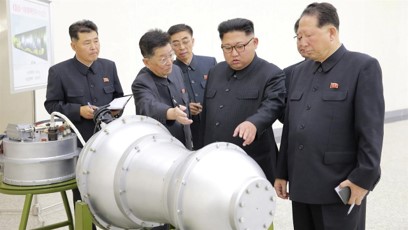
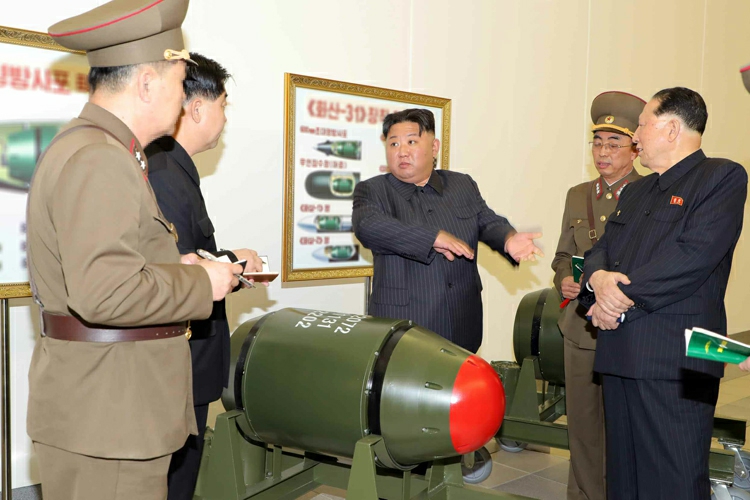
Figure 1. Photographs of models of nuclear weapons by North Korea, in 2016 (top left), 2017 (top right), and 2023 (bottom.)
Top left: This round object was captioned as a thermonuclear weapon, which if true could represent a model of a smaller one-stage thermonuclear weapon that typically has a spherical shape. It has an estimated diameter of 60 to 70 cm, which is larger than expected for a pure fission weapon within North Korea’s capabilities at that time, but consistent with it being a model of a one-stage thermonuclear weapon. The flange may be to attach the warhead to structures in the nosecone of a missile (shown in the photo on lower left).
Top right: Purported model of a two-stage thermonuclear weapon being viewed by Kim Jong Un; the photo was released shortly before North Korea’s September 2017 underground nuclear test. There is little support for North Korea’s ability to field such a weapon. A photo on the left of this image shows the warhead in the nosecone of a missile. At the time, North Korea stated, “thermonuclear nuke with great destructive power which can be detonated even at high altitudes for super-powerful EMP (electromagnetic pulse) attack according to strategic goals.”
The bottom image shows a March 28, 2023 model of an interchangeable tactical nuclear weapon, called the Hwason-31, allegedly able to be placed in multiple delivery vehicles. A picture behind Kim Jong Un shows eight missiles with this warhead in their nosecone. Hwason means volcano in Korean; the reason for the designation “31” is unclear. The warhead inside the outer casing is estimated to have a diameter of about 40 to 45 centimeters and could be a levitated fission weapon with a predicted yield of about 10 kt, although the latter assessment is highly uncertain.
Traditional Estimate of North Korea’s Nuclear Arsenal, Creating the Upper Bound
The traditional estimate assumes that the arsenal is composed of relatively simple fission weapons, composed of some made only with plutonium and most made only with weapon-grade uranium. This estimate for reasons discussed subsequently is probably an overestimate of the actual arsenal at the end of 2022, but it can serve as an upper bound. A further limitation of this type of estimate is that it involves nuclear weapons with explosive yields on order of 10-15 kilotons. Nonetheless, this method remains a way to derive a basic understanding of the number of nuclear weapons North Korea could build and to compare the results to other researchers’ estimates, which often use a similar methodology.
The method used to estimate the number of nuclear weapons involves several steps. The first is to estimate the amount of WGU and plutonium produced through 2022. The next is to derive the number of nuclear weapons.
The estimate is calculated using Crystal Ball software, which allows for the incorporation of the many uncertainties intrinsic to this calculation. The Monte Carlo-based software makes thousands of independent calculations where individual variables are sampled based on their range of possibilities, resulting in a distribution of estimate. In these estimates, the median, or mid-point, and 5th and 95th percentiles are used to characterize the results. These percentiles are chosen, rather than the full range of calculated values, in order to reduce the effect of outliers in the calculations.
The median of this slightly skewed distribution is 72 nuclear weapons, with a range of 55 to 96 nuclear weapons, representing the 5th and 95th percentiles (see Figure 2). Rounding gives a range of 55 to 95 with a median of about 70 nuclear weapons.
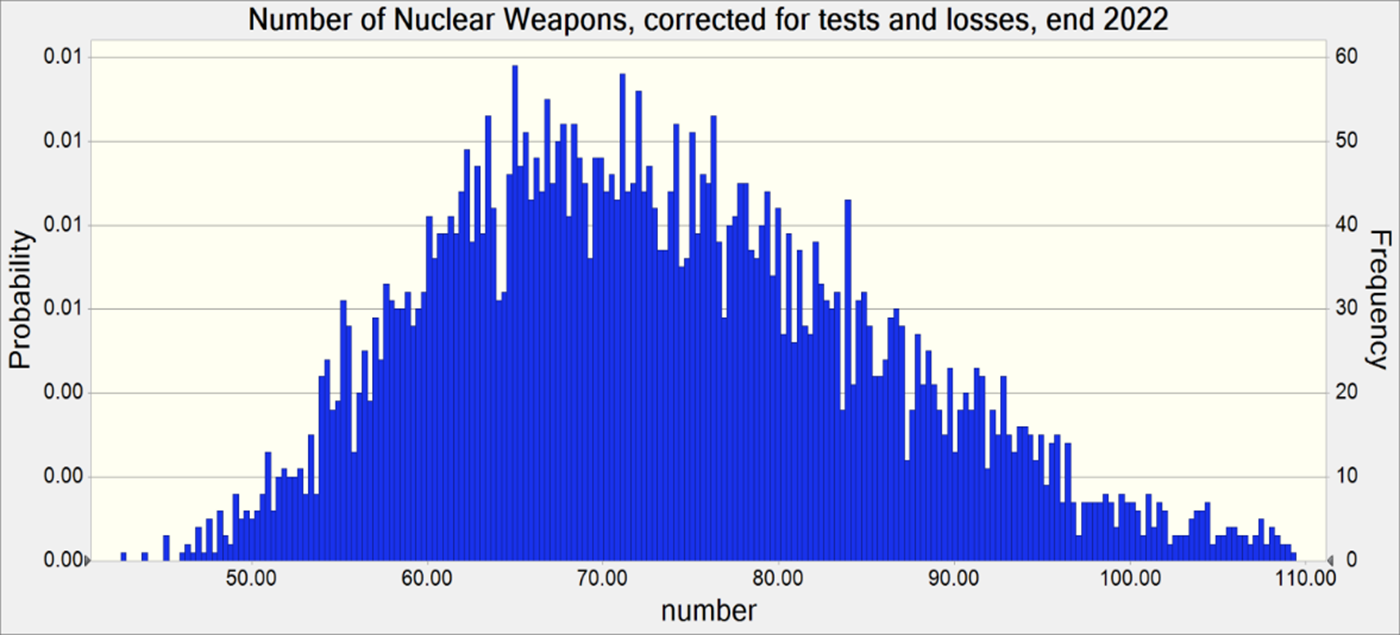
Figure 2. The distribution of the estimated number of nuclear weapons at the end of 2022, factoring in losses from nuclear tests, processing losses, a production pipeline requirement, and a strategic reserve of plutonium and weapon-grade uranium.
Under this estimate, the amounts of separated plutonium and weapon-grade uranium, or fissile material, produced as of the end of 2022, follow:
Separated Plutonium: 63 kg median with 56 to 70 kg as the 5th and 95th percentile
Weapon-Grade Uranium: 1770 kg median with 1425 to 2185 kg as the 5th and 95th percentile
North Korea has a relatively limited amount of plutonium and a large WGU stock, reflecting its relative success in making WGU, and the relative constraint imposed by operating only a small reactor able to make plutonium.
It is worth listing several of the underlying facts and assumptions that go into the calculation of the amounts of these fissile materials and weapons stocks, and some of the main reasons why these calculations, and resulting distributions, contain significant ranges.
Key assumptions in the estimate of fissile material stockpiles, which remain the same for all weapons’ estimates:
- In addition to the Yongbyon enrichment plant, there is at least one secret centrifuge plant, possibly there are two such plants.
- Number of centrifuges and type: 7000 to 10,000 P2-type centrifuges operating from 2015 to the end of 2022, 6000 to 8000 P2 centrifuges from 2010 until 2015, and 4000 to 6000 of them operating during at least part of the period from 2006 to 2010:
o Yongbyon Centrifuge plant: 2000 P2-type centrifuges operated at the Yongbyon centrifuge plant between 2010 and 2015, where some of the output was low enriched uranium for eventual use in the ELWR under construction at Yongbyon. From 2015 to the end of 2022, the Yongbyon centrifuge plant had 3000 to 4000 P2-type centrifuges in operation.
o Other centrifuge plant(s): 4000 to 6000 P2-type centrifuges operating at a second centrifuge plant that started operating sometime between 2006 and 2010.
- The upper bound in the total number of P2-type centrifuges is set by North Korean procurements for its centrifuge program, as uncovered by several governments since the early 2000s.
- The enrichment plants have encountered significant inefficiencies in centrifuge operation when producing WGU.
- IAEA safeguards reports, along with commercial satellite imagery and known characteristics of the 5 MWe reactor’s operation, are used to derive plutonium production and separation since about 2013. For earlier periods, information is garnered from North Korean declarations under the Six Party process, earlier IAEA reports, commercial satellite imagery, and U.S. and allied governmental reporting. From these sources, it is clear that North Korea faces a relative plutonium shortage, compounded by the operational difficulties of the small 5 MWe reactor.
- Natural uranium supply is adequate (in fact North Korea may have an excess, which rumors suggest is being sold to China secretly).
Key assumptions for fissile material stockpile management and losses (the same for all weapons’ estimates):
- The six underground tests led to reductions in the overall number of weapons.
- A 30 percent reduction in the amount of weapon-grade uranium and a 20 percent reduction in the amount of plutonium is taken before calculating nuclear weapons totals. The reasons include:
o Inevitable losses during processing;
o Significant amount of WGU is in the production pipeline—at the enrichment plant, various conversion facilities, weapons’ core fabrication sites, and in transport. The amount in the entire production pipeline can measure more than double the amount that is used each year in finished nuclear weapons;
o Scrap, which can form 20 percent of the total amount of WGU allocated to a weapon, is likely recovered more slowly than new material is produced; and
o A reserve of plutonium and weapon-grade uranium likely exists, for facilitating unexpected contingencies and for making up for supply chain disruptions, such as the enrichment plant not producing expected quantities or a conversion plant failing to meet its quotas. These reserve stocks could also be equivalent to a whole year of production of warheads. In addition, faced with a centrally planned authoritarian system, key plant managers may keep a larger reserve out of fear of the consequences of not meeting annual quotas.
Key assumption of the amount of fissile material per simple fission weapon:
- The amount of plutonium and WGU in each weapon must be estimated (see Figure 3). Probability distributions are used, where more is known about plutonium content than WGU content per weapon. For example, a knowledgeable government source stated that it has evidence that North Korea’s plutonium-only weapon contained four kilograms of weapon-grade plutonium, a value that is consistent with the peak of about 3.5 kg in the top figure in Figure 3. For WGU, less information is available and a uniform probability distribution between 15 and 25 kg is used. It should be noted that North Korean weaponeers could be learning through ongoing underground nuclear testing to use significantly less of either fissile material while keeping the explosive yield the same. However, based on the Institute’s current understanding of North Korea’s practices and capabilities, the ranges in Figure 3 reflect amounts that do not unduly risk lowering the explosive yield or complicating miniaturization.
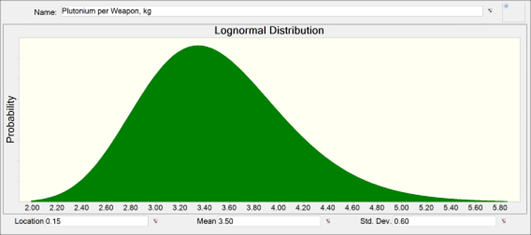

Figure 3. Probability distributions of plutonium and WGU per weapon, as they appear in the Crystal Ball software.
Comparison to an Earlier Estimate of Nuclear Weapons, at end of 2017
Figure 4 shows a traditional Institute estimate from the end of 2017.6 The Crystal Ball distribution of estimates, based on the same or similar uncertainties as described above, has a median of 41 nuclear weapons, with a range of 31 to 56 nuclear weapons, where the 5th and 95th percentiles are used to represent the range. These values are rounded to 40 nuclear weapons with a range of 30 to 55 nuclear weapons.
Comparing the medians of the 2017 and 2022 distributions, the size of North Korea’s arsenal, assuming they are simple fission weapons, has increased by about 75 percent, at an average rate of about 6 nuclear weapons per year between the end of 2017 and the end of 2022. Figure 5 is a graph showing the growth of North Korea’s nuclear arsenal since the early 1990s, where each estimate is based on the traditional method, making them comparable. As can be seen, the estimated number of nuclear weapons has increased significantly over time, as has the estimate’s uncertainty, as evidenced by the height of the bars.
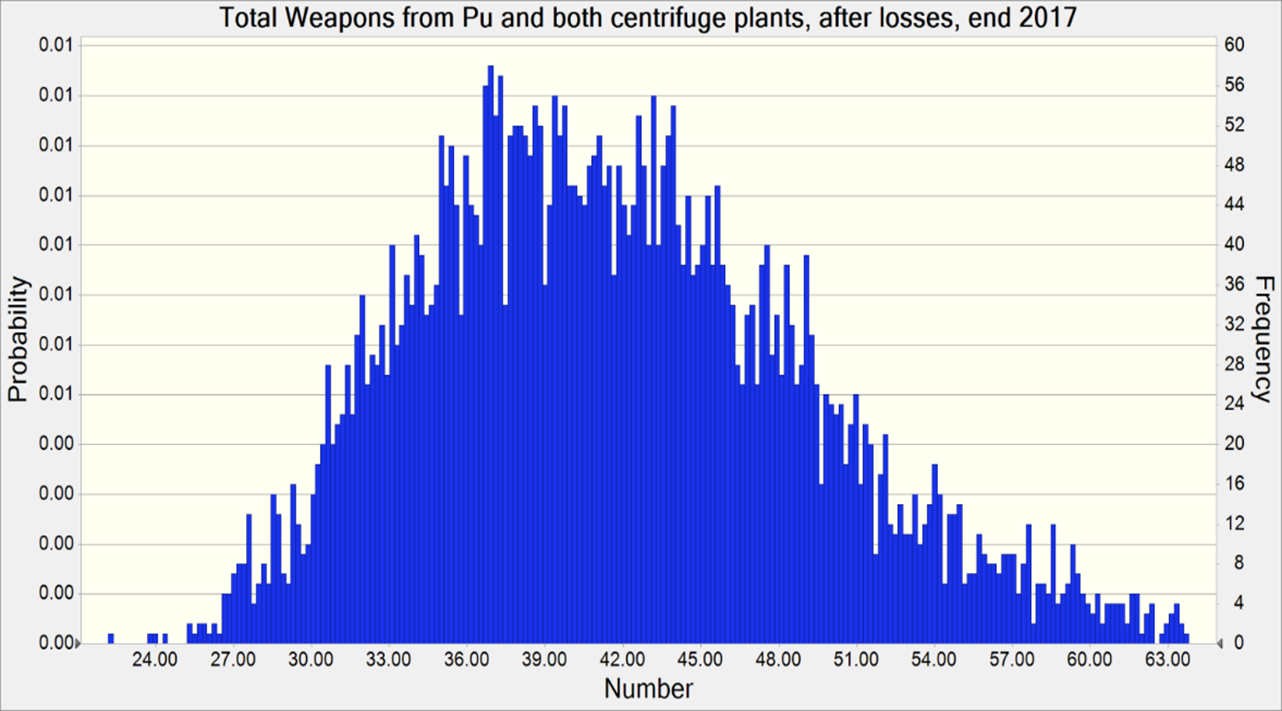
Figure 4. The distribution of the estimated number of nuclear weapons at the end of 2017, factoring in losses from nuclear tests, processing losses, a pipeline requirement, and a strategic reserve of plutonium and weapon-grade uranium.
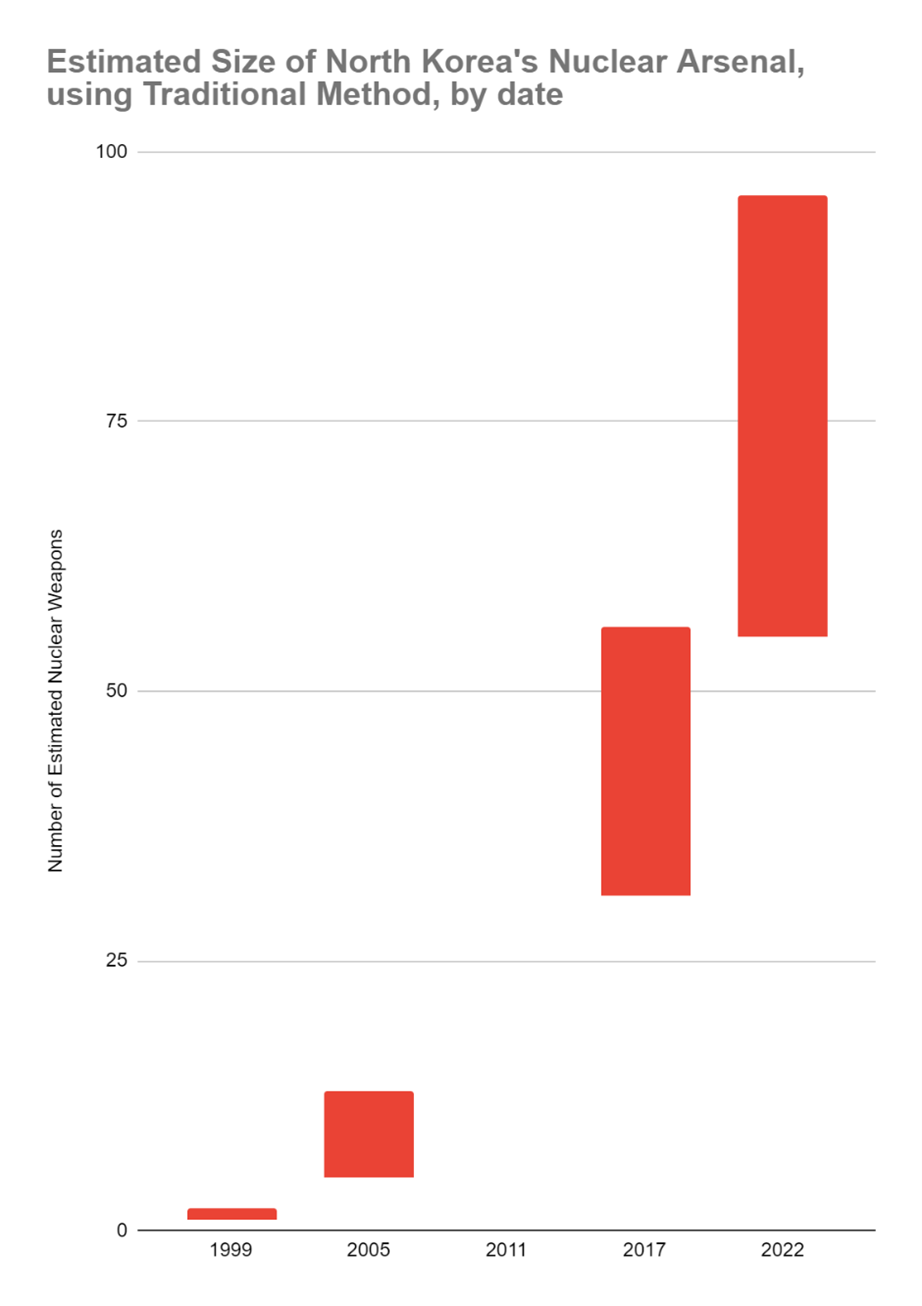
Figure 5. Estimated size of North Korea’s nuclear arsenal, using the traditional method of estimation, with only ranges included, by date.
Alternative Estimates, Creating the Lower Bound
The traditional estimate is no longer sufficient for several reasons, the main one being that it assumes all weapons are simple fission weapons with relatively low explosive yields, when North Korea is, in fact, widely believed to be able to build thermonuclear weapons that typically contain more weapon-grade uranium than simple fission weapons, sometimes substantially more. North Korea may also be building nuclear weapons that contain both WGU and plutonium, as a way to increase their explosive yield. Thus, its arsenal could be substantially higher in yield but lower in number. As such, these additional estimates lead to smaller, yet more powerful nuclear arsenals.
A Lower Bound, with every nuclear weapon composed of both plutonium and WGU, a “composite” nuclear weapon
A composite core nuclear weapon is a design with both plutonium and weapon-grade uranium in the core of the weapon. Some government officials believe North Korea’s arsenal is mainly composite core nuclear weapons, according to a knowledgeable government official.
North Korea may favor a composite core because of a plutonium shortage, yet wants to miniaturize its weapons while achieving higher explosive yields. The plutonium could be in a spherical shape at the center of the device with weapon-grade uranium shells around the plutonium. In this design, the weapon-grade uranium would stretch the plutonium supply while opening up ways to increase the yield of the explosion.
North Korea (or Democratic People’s Republic of Korea (DPRK)) suggested that it could be building composite cores after its September 2016 nuclear test, estimated to have achieved a yield of 15 to 25 kilotons.
“The standardization of the nuclear warhead will enable the DPRK to produce at will and as many as it wants a variety of smaller, lighter, and diversified nuclear warheads of higher strike power with a firm hold on the technology for producing and using various fissile materials. This has definitely put on a higher level the D.P.R.K.’s technology of mounting nuclear warheads on ballistic rockets.” [emphasis in italics added] -“DPRK Succeeds in Nuclear Warhead Explosion Test,” KCNA, Sept. 9, 2016.
Key assumption for the amount of fissile material per composite weapon:
- Each weapon contains two kg of plutonium and 10 to 15 kg of WGU, where the yield can exceed 15 kilotons of explosive energy, possibly greatly exceeding that yield. A larger amount of WGU is used in each weapon here than in previous estimates to allow for a greater explosive yield.
Key assumption for the resulting nuclear arsenal:
- North Korea would focus on building this type of weapon only and thus the total number of weapons is constrained to the available separated plutonium supply.
The median for an arsenal of only composite weapons is 20 nuclear weapons with a range of 17 to 23, representing the 5th and 95th percentiles (see Figure 6.) This results in the lower bound for the overall arsenal estimate for late 2022.
After allocating WGU to these weapons, North Korea would have a remaining WGU stock estimated at 1460 kg of WGU, with a range of 1100 to 1900 kg of WGU, ignoring any reduction in this estimate from testing or processing the material.
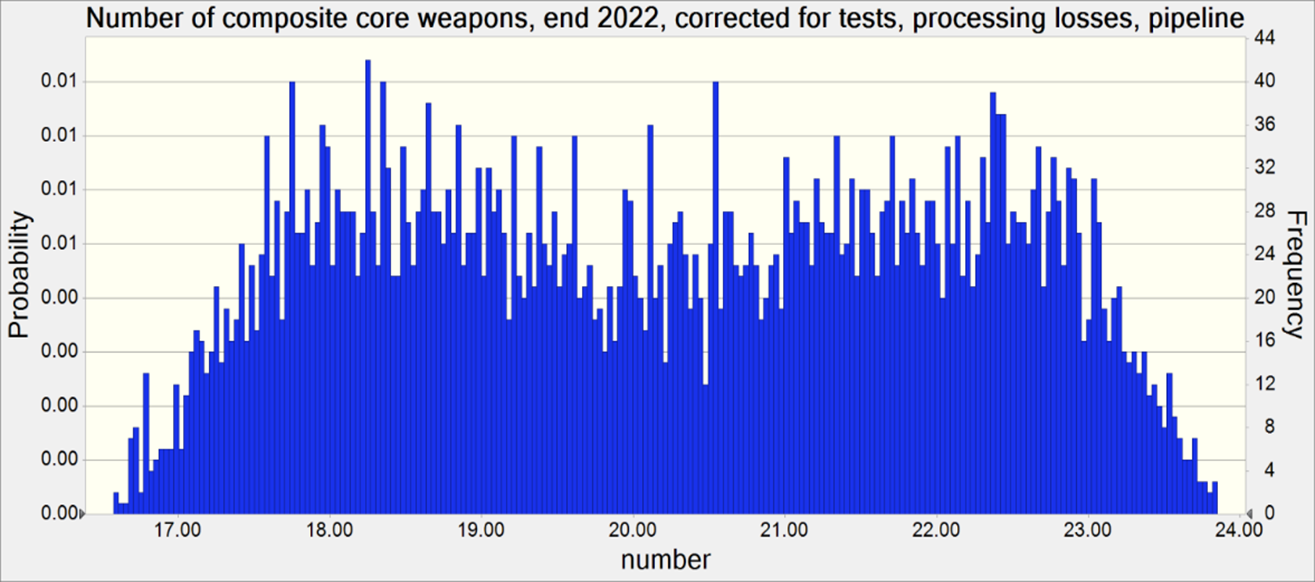
Figure 6. The distribution of the estimated number of composite nuclear weapons at the end of 2022, factoring in losses from nuclear tests, processing losses, a production pipeline requirement, and a strategic reserve of plutonium.
Effect of Operation of the ELWR. The operation of the ELWR, and its nominal production of about 20 kg of weapon-grade plutonium each year, would allow for a significant increase in the annual production of composite nuclear weapons, at a rate of about eight such weapons a year (with a 20 percent reduction taken and a relatively large unused stock of WGU, as discussed above), allowing a rapid growth in this particular arsenal.
An arsenal with single-stage thermonuclear weapons, in addition to simple fission weapons
A one-stage thermonuclear warhead, sometimes called a layer cake, alarm clock, or onion design, is a spherical device that typically has a plutonium core and weapon-grade uranium shells interspersed with lithium 6-deuteride shells. Sometimes solidified forms of tritium are used with the lithium deuteride. A one-stage thermonuclear weapon illustration, created by the Institute, can be seen in Figure 7. See also Figure 1.
A British one-stage thermonuclear device tested in the mid-1950s had a plutonium core and 100 kg of weapon-grade uranium in shells. It achieved a yield of several hundred kilotons. Russia’s fourth nuclear test on August 12, 1953, was of the RDS-6s (also known as Joe 4), a one-stage thermonuclear device that achieved a yield of 400 kt. It subsequently was weaponized.
North Korea is more likely to be able to build a one-stage thermonuclear weapon than a two-stage thermonuclear weapon, despite its official statements to the contrary. One-stage designs include many subtypes of varying difficulty, although all are complex to achieve. Nonetheless, several types of one-stage designs are judged as within North Korea’s capability to build.
In general, Institute assessments tend to discount North Korea’s current ability not only to build deliverable two-stage thermonuclear weapons but also U.S.-style boosted nuclear weapons. The latter involves injecting a tritium-deuterium gas stored under high pressure in a specialized container into a hollow shell of plutonium or weapon-grade uranium right before detonation, causing up to a ten-fold increase in yield compared to one with only the fissile material.
Key assumption for the amount of fissile material per single-stage thermonuclear weapon:
- Each thermonuclear weapon contains about 3.5 kg of plutonium and 80 kg of WGU.
Key assumption for the resulting nuclear weapons arsenal:
- North Korea would not only build these five thermonuclear weapons. The rest of the arsenal would contain plutonium-based and WGU-based weapons, as defined earlier.
The median for an arsenal of thermonuclear weapons and simple fission weapons is 49 nuclear weapons, with a range of 31 to 74 weapons as 5th and 95th percentiles (see Figure 8.) This arsenal would have five single-stage thermonuclear weapons with the rest simple plutonium-based and weapon-grade-based fission weapons, where, if considering only medians, about 74 percent of the total weapons are WGU-based fission weapons.

Figure 7. Illustrative Concept of a One-Stage Thermonuclear Weapon.
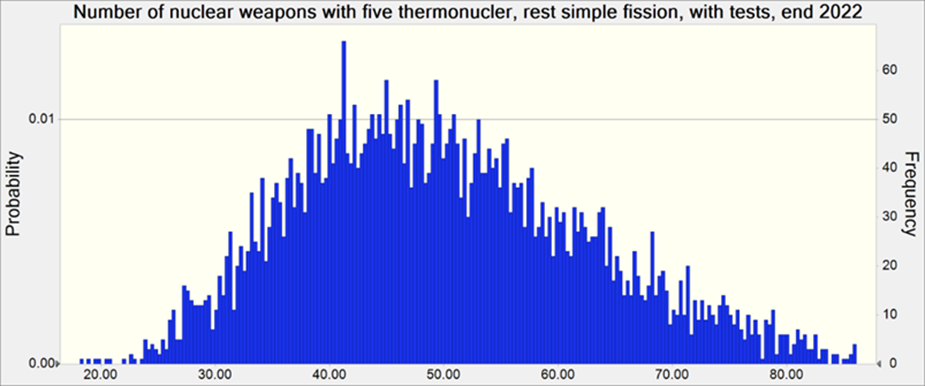
Figure 8. The distribution of the estimated number of nuclear weapons in an arsenal containing five one-stage thermonuclear weapons and the rest simple fission weapons at the end of 2022, factoring in losses from nuclear tests, processing losses, a production pipeline requirement, and a strategic reserve of plutonium and weapon-grade uranium.
Additional Combinations of Nuclear Weapons Types Lead to Similar Arsenals
Adding five composite core weapons to the arsenal of thermonuclear weapons and simple fission weapons would lower the number of simple fission weapons, but the overall number of weapons does not change that significantly. This arsenal made up of five one-stage thermonuclear weapons, five composite core nuclear weapons, and the rest simple fission weapons, results in a median of 47 weapons with a range of 30 to 73 (5th and 95th percentiles, respectively). See Figure 9.
Adding a few one-stage thermonuclear weapons to the composite core estimate would lower the median (and the range) slightly due to using more plutonium in each such weapon. (There would be a more than sufficient stock of unused WGU to fuel these relatively few thermonuclear weapons.)
If an arsenal of only one-stage weapons was created, it would be similar in number to the composite-core only arsenal, with a median slightly above 20 nuclear weapons.
If two-stage thermonuclear weapons were included instead of one-stage weapons, the median for all arsenals considering thermonuclear weapons would likely rise, since less WGU is used in a two-stage weapon than in a one-stage weapon. However, as explained above, North Korea is not believed to have achieved a two-stage thermonuclear weapon. In any case, such an arsenal would not exceed in size the arsenal derived by the traditional method.
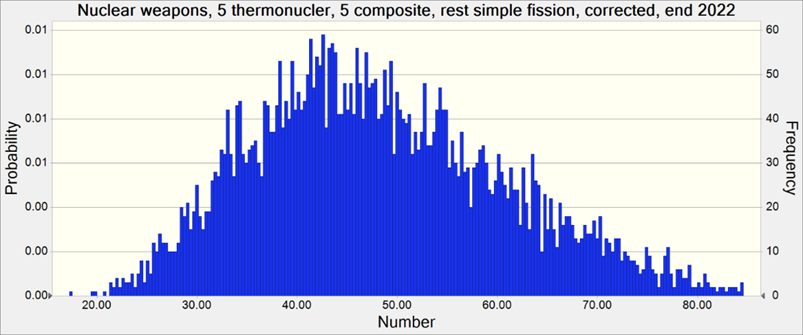
Figure 9. The distribution of the estimated number of nuclear weapons in an arsenal containing five one-stage thermonuclear weapons, five composite nuclear weapons, and the rest simple fission weapons, at the end of 2022, factoring in losses from nuclear tests, a production pipeline requirement, processing losses, and a strategic reserve of plutonium and weapon-grade uranium.
Weighted Average of Three Main Distributions
Given that each of the three main estimates is a reasonable possibility, based on currently available information, they can be combined into a single distribution by averaging, where each distribution receives equal weight. The result is a slightly skewed distribution with a median of 46 weapons and a range of 35 to 63 nuclear weapons, the 5th and 95th percentile, respectively (see Figure 10).
The averaging process, combined with using the 5th and 95th percentiles, reduces the range resulting from combining the 5th percentile of the composite core arsenal with the 95th percentile of the traditional estimate. That range would be 17 to 96 weapons (see Table 1) and appears overly large.
This “average” arsenal captures the information from all three arsenals and may be the one reflecting best our state of knowledge of North Korea’s nuclear arsenal today. Although its exact composition cannot be determined from the calculation, it can be viewed as containing a mix of composite core nuclear weapons, thermonuclear weapons, and plutonium-only and WGU-only nuclear weapons. The thermonuclear weapons would have the highest explosive yields, followed by the composite cores, and then the simpler plutonium-only and WGU-only fission weapons. The last category probably contains different versions, some built earlier than others. This category may also contain an increasing number of Hwason-31 interchangeable tactical nuclear warheads, assuming a future underground test is not needed to demonstrate its workability.
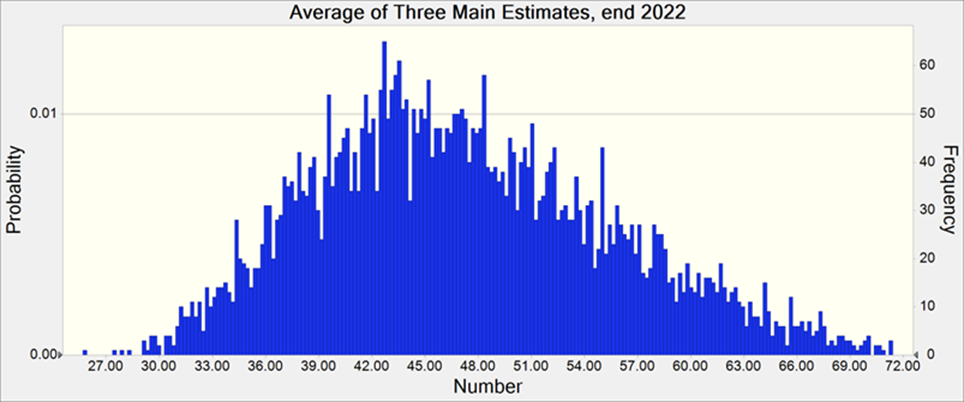
Figure 10. Average of Three Main Estimates, each weighted equally, end 2022.
Last Word
As can be appreciated by the calculations in this report, the uncertainties in predicting the size of fissile material stocks and nuclear arsenals remain relatively large.
The three main arsenals that are considered—simple fission weapons only, composite core weapons only, and a combination of thermonuclear weapons and simple fission weapons and/or composite core weapons—are not the only arsenals possible. However, many of the other possible arsenals will fall near or within the range of numbers of nuclear weapons created by the traditional and composite core-only arsenals, where the former represents the upper bound of weapons, and the latter captures the lower bound. This allows for averaging the three distributions, giving a result that may better reflect our current state of knowledge about North Korea’s nuclear arsenal, as we await more information that will afford a more accurate picture of this increasingly dangerous arsenal.
1.“Respected Comrade Kim Jong Un Guides Work for Mounting Nuclear Warheads on Ballistic Missiles,” Rodong Sinmun, March 28, 2023, accessed March 30, 2023. ↩
2. In earlier Institute reports, it was shown that the ELWR could produce weapon-grade uranium, at a rate of about 20 kg per year, a rate considerably greater than that of the 5 Mwe reactor at Yongbyon. See for example, David Albright, “North Korean Plutonium and Weapon-Grade Uranium Inventories,” Institute for Science and International Security, January 8, 2015 (revised October 7, 2015), https://isis-online.org/uploads/isis-reports/documents/North_Korean_Fissile_Material_Stocks_Jan_30_2015_revised_Oct_5_2015-Final.pdf. ↩
3. David Albright and Kevin O’Neill, Solving the North Korean Nuclear Puzzle(Washington, D.C.: ISIS Press, 2000). ↩
4. “The North Korean Plutonium Stock Mid-2005,” Institute for Science and International Security, September 7, 2005, https://isis-online.org/uploads/isis-reports/documents/DPRK_Plutonium_Stock_2005.pdf. ↩
5. David Albright, “Understanding North Korea’s Nuclear Weapon Capabilities,” Institute for Science and International Security, May 9, 2018, https://isis-online.org/isis-reports/detail/understanding-north-koreas-nuclear-weapon-capabilities/10. ↩
6.The original 2017 estimate has been modified to allow it to be compared to the one through 2022. The modifications shift the range and median of the original 2017 estimate. ↩



 twitter
twitter